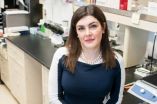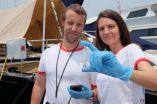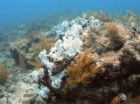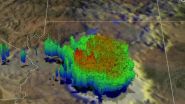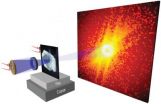Blocking one receptor could halt rheumatoid arthritis
2014-09-10
(Press-News.org) Researchers at the University of Illinois at Chicago College of Medicine have shown for the first time how the activation of a receptor provokes the inflammation and bone degradation of rheumatoid arthritis -- and that activation of this one receptor, found on cells in the fluid of arthritic joints, is all that is required.
Their findings, published online in the Journal of Immunology, point to a new therapeutic target to interrupt the vicious cycle of inflammation and bone erosion in rheumatoid arthritis.
Rheumatoid arthritis is a progressive autoimmune inflammatory disease of the joints. Swelling and pain, caused by certain cells flooding into the joints, is a hallmark of the disease, along with progressive bone loss. The UIC researchers have shown that the process begins with the triggering of a single receptor on a group of white blood cells.
"TLR5 does it all," says Shiva Shahrara, UIC associate professor of rheumatology and corresponding author on the paper. TLR5, or toll-like receptor 5, is found on myeloid, or marrow-derived, cells that migrate from the blood into affected joints. Shahrara and her colleagues found that the receptor is much more abundant on myeloid cells found in the fluid of joints in patients with rheumatoid arthritis as compared to samples from healthy subjects.
In previous studies, Shahrara and her colleagues found that activation of TLR5 causes abnormal blood vessel formation in the joints of rheumatoid arthritis patients. In the new study they found that the receptor also up-regulates a potent inflammatory molecule called TNF-alpha, which recruits even more myeloid cells into the joint, where they are transformed into bone-degrading cells called osteoclasts.
In a series of experiments, the researchers uncovered multiple pathological processes driven by the activation of the receptor.
When the researchers placed TLR5-expressing myeloid cells next to joint fluid from rheumatoid arthritis patients, the cells migrated into the fluid. But if the receptor was blocked by an antibody, cell migration towards the fluid was significantly reduced.
Something in the joint fluid attracts cells with TLR5, Shahrara said -- perhaps TLR5's binding protein, which is most likely present in joints affected by rheumatoid arthritis.
The researchers also found that levels of TNF-alpha increased in joint fluid from patients with rheumatoid arthritis when myeloid cells with activated TLR5 were present. Patients with rheumatoid arthritis who take anti-TNF-alpha drugs have lower levels of TLR5 on their myeloid cells, suggesting that a positive feedback loop exists between TLR5 and TNF-alpha, so that an elevation in one causes an increase in the other.
"Not only do TLR5 and TNF-alpha regulate each other, but they work synergistically to attract more myeloid cells into the joint, where they are transformed into bone-eroding cells," Shahrara said.
In a mouse model of rheumatoid arthritis, experimental mice given an antibody that blocked the TLR5 receptor had markedly reduced joint swelling and bone erosion compared to controls. The TLR5 antibody treatment may reduce swelling by lowering the number of myeloid cells migrating into the joints to become osteoclasts, the researchers said.
Based on her studies in mice, Shahrara thinks a drug that prevents TLR5 activation could slow or prevent the inflammation and bone erosion of later-stage rheumatoid arthritis in patients.
"When TLR5 is activated, it initiates a vicious feedback loop that results in a worsening of both the inflammatory and erosive features of rheumatoid arthritis," Shahrara said. "The receptor is a major driver of inflammation and bone degradation. Blocking this receptor could have significant therapeutic value in interrupting joint swelling and bone loss in patients with rheumatoid arthritis."
INFORMATION:
Seung-jae Kim, Zhenlong Chen, Nathan Chamberlain, Abdul Essani, Dr. Suncica Volkov, Dr. Shiva Arami, Dr. William Swedler, Dr. Anjali Mehta and Dr. Nadera Sweiss from the UIC College of Medicine; Michael Volin of Midwestern University Chicago College of Osteopathic Medicine in Downers Grove, Illinois; Dr. M. Asif Amin of the University of Michigan Medical School; Dr. Ellen Gravallese of the University of Massachusetts, Worcester; and Dr. Nancy Lane of the University of California, Davis Medical Center, are co-authors on the paper.
This research was supported by grants AR056099 and AR065778 from the National Institutes of Health, grant PR093477 from the Department of Defense, a grant from Within Our Reach from The American College of Rheumatology and an Arthritis Foundation Innovative Research Grant.
ELSE PRESS RELEASES FROM THIS DATE:
NTU partners international universities to build a network of citizen oceanographers
2014-09-10
Nanyang Technological University (NTU) is working with other international universities to build a global network of 'citizen scientists' on a free-to-access database for oceanographic data.
While much attention is placed on mammals and fish in the sea, it is the tiny, marine microbes that supports the nutrient cycle and forms the foundation of the food web. Known as the marine microbiome, they are the most abundant organisms in the ocean but also the least understood.
To gain a better understanding of such marine life and its environment, NTU scientists at the Singapore ...
Residual hydraulic fracturing water not a risk to groundwater
2014-09-10
Hydraulic fracturing -- fracking or hydrofracturing -- raises many concerns about potential environmental impacts, especially water contamination. Currently, data show that the majority of water injected into wells stays underground, triggering fears that it might find its way into groundwater. New research by a team of scientists should help allay those fears.
In a paper published in the current issue of the Journal of Unconventional Oil and Gas Resources, Terry Engelder, professor of geosciences, Penn State; Lawrence Cathles, professor of earth and atmospheric sciences, ...
Penn research shows how brain can tell magnitude of errors
2014-09-10
University of Pennsylvania researchers have made another advance in understanding how the brain detects errors caused by unexpected sensory events. This type of error detection is what allows the brain to learn from its mistakes, which is critical for improving fine motor control.
Their previous work explained how the brain can distinguish true error signals from noise; their new findings show how it can tell the difference between errors of different magnitudes. Fine-tuning a tennis serve, for example, requires that the brain distinguish whether it needs to make a ...
Ocean warming affecting Florida reefs
2014-09-10
ST. PETERSBURG, Fla.— Late-summer water temperatures near the Florida Keys were warmer by nearly 2 degrees Fahrenheit in the last several decades compared to a century earlier, according to a new study by the U.S. Geological Survey.
Researchers indicate that the warmer water temperatures are stressing corals and increasing the number of bleaching events, where corals become white resulting from a loss of their symbiotic algae. The corals can starve to death if the condition is prolonged.
"Our analysis shows that corals in the study areas are now regularly experiencing ...
Networking can make some feel 'dirty,' says new study
2014-09-10
Toronto – If schmoozing for work leaves you with a certain "ick" factor, that's not just awkwardness you're feeling.
Professional networking can create feelings of moral impurity and physical dirtiness, shows a new study.
That can hold people back from networking more, reducing career opportunities and lowering job performance, says study co-author Tiziana Casciaro, an associate professor of organizational behaviour and human resource management at the University of Toronto's Rotman School of Management. The study was co-written with fellow researchers Prof. Francesca ...
New evidence points to outcomes and cost benefits of telemedicine
2014-09-10
New Rochelle, NY, September 10, 2014—Congestive heart failure, stroke, and chronic obstructive pulmonary disease (COPD) are three of the leading causes of death in the U.S. The use of telemedicine to help manage chronic diseases such as these can yield clear benefits including fewer and shorter hospital stays, fewer emergency room visits, less severe illness, and even fewer deaths, as reported in a study published in Telemedicine and e-Health, a peer-reviewed journal from Mary Ann Liebert, Inc., publishers. The article is available free on the Telemedicine and e-Health ...
Halving the risk of preterm birth for some twin pregnancies
2014-09-10
International research involving the University of Adelaide has found that the risk of preterm birth could be halved for a specific group of "super high-risk" twin pregnancies.
The results could help to save babies' lives throughout the world and prevent serious health complications after birth.
The study, involving researchers from the University of Adelaide's Robinson Research Institute, reviewed all of the previous large studies conducted into the use of progestogen hormones, which have been trialed over the past 10 years to help prevent preterm birth in twins. ...
NASA tracks Norbert moisture to Arizona's drenching thunderstorms
2014-09-10
VIDEO:
This simulated flyby of NASA's TRMM satellite on Sept. 8 saw rain falling at a rate of over 62 mm (2.4 inches) per hour in some downpours over Arizona. Some...
Click here for more information.
Post-tropical storm Norbert may have been centered a couple of hundred miles off the northwestern coast of Mexico's Baja California, but the flow of warm, moist air that spun around it generated drenching thunderstorms over Arizona. NASA's TRMM satellite saw Norbert's remnants and ...
Where to grab space debris
2014-09-10
Objects in space tend to spin — and spin in a way that's totally different from the way they spin on earth. Understanding how objects are spinning, where their centers of mass are, and how their mass is distributed is crucial to any number of actual or potential space missions, from cleaning up debris in the geosynchronous orbit favored by communications satellites to landing a demolition crew on a comet.
In a forthcoming issue of the Journal of Field Robotics, MIT researchers will describe a new algorithm for gauging the rotation of objects in zero gravity using only ...
Advanced light source sets microscopy record
2014-09-10
A record-setting X-ray microscopy experiment may have ushered in a new era for nanoscale imaging. Working at the U.S. Department of Energy (DOE)'s Lawrence Berkeley National Laboratory (Berkeley Lab), a collaboration of researchers used low energy or "soft" X-rays to image structures only five nanometers in size. This resolution, obtained at Berkeley Lab's Advanced Light Source (ALS), a DOE Office of Science User Facility, is the highest ever achieved with X-ray microscopy.
Using ptychography, a coherent diffractive imaging technique based on high-performance scanning ...
